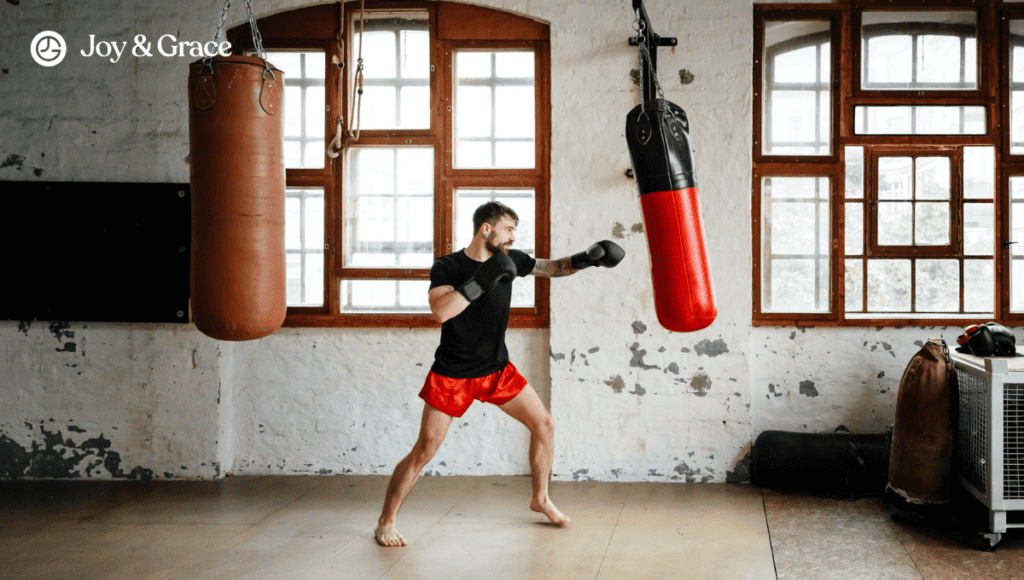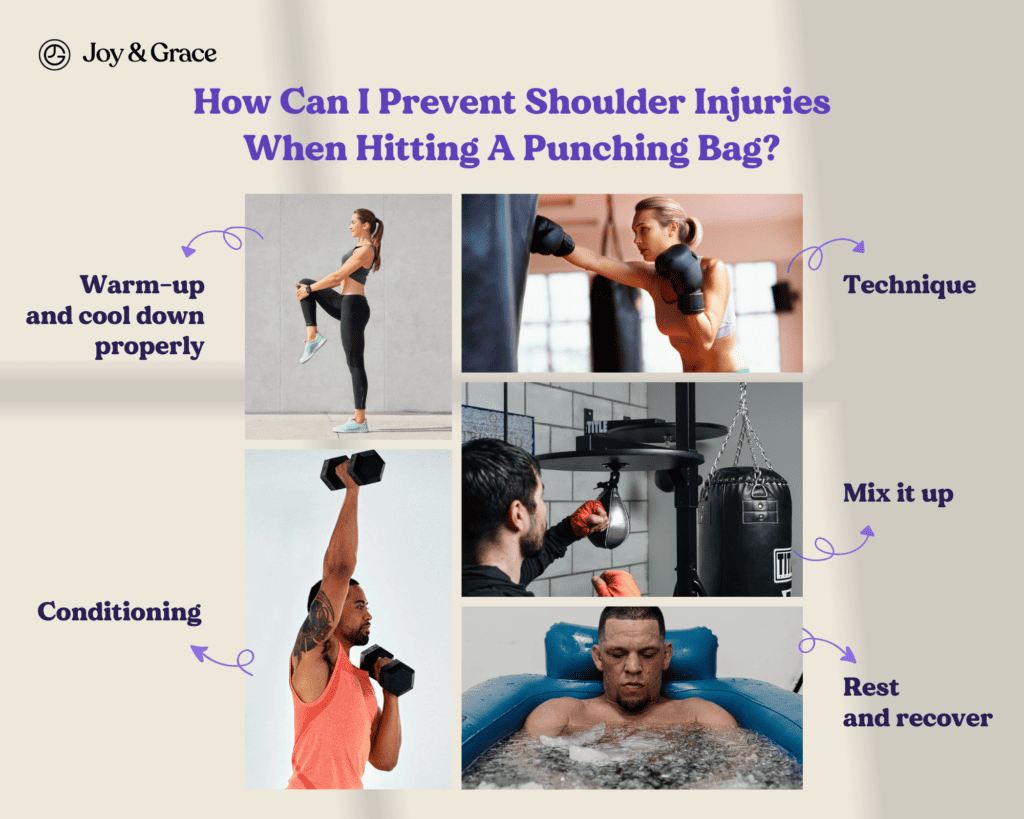Heavy bag punching is a common boxing drill, but if you've noticed shoulder or neck pain after boxing class, you're not alone.
Many champions in the making notice discomfort, especially when throwing sharp hooks on the punching bag. All of this is part of the game, but no one truly wishes to carry these aches beyond the ring.
Today, we're addressing the shoulder and neck pain that boxers often encounter.
Let's hit this straight on, shall we?
Why Does My Shoulder Hurt After Punching The Bag?

Whether you're a seasoned pro or just beginning with the punching bag, the following might be to blame if you're grappling with shoulder pain:
- Incorrect punching technique
You may strain your shoulder joints and muscles excessively if you don't use the proper punching technique.
Shoulder pain from the heavy bag often occurs when you fail to rotate your shoulder correctly during a punch. Throwing punches incorrectly can lead to overextension or awkward angles that can cause pain.
Moreover, the impact of the punch itself can jar your shoulder muscles and tendons. But, as highlighted in a study, shoulder injuries from punching are more frequently a result of improper technique than the actual impact of the punch.

- Overuse or fatigue
Repeatedly punching a heavy bag for extended periods of time can lead to muscle fatigue and strain. Over time, this can cause pain in the shoulder area. According to a study, repeated forward movement in punching can cause micro-trauma to the shoulder capsule.
An additional cause of the pain might also be your own body's reaction to the punch. For instance, when you punch, you may unconsciously stiffen your shoulder for the impact. If repeated often, this behavior can exacerbate shoulder pain from punching a heavy bag.
- Poor warm-up or inadequate stretching
Failing to warm up properly or not stretching your shoulders and upper body muscles before hitting the bag can increase the risk of injury and pain.
- Shoulder muscle imbalances
Imbalanced or weak shoulder muscles can make you more susceptible to injury when punching a bag. It's important to maintain overall shoulder strength and balance.
- Prior shoulder injuries
If you have a history of shoulder injuries or any underlying shoulder conditions, punching a bag can exacerbate these issues. We’ll talk more about these conditions later.
- Incorrect bag setup
If the heavy bag is hung at an improper height or angle, it can force you to use an awkward punching motion, leading to shoulder pain.
While some discomfort can be expected after rigorous activity, it's essential to distinguish between normal soreness and injury-related pain.
Is Shoulder Pain Normal After Hitting A Punching Bag?
As with any workout, a little soreness in the shoulder is expected after repeatedly hitting a punching bag. As mentioned above, repetitive punching can stress your shoulder muscles. Furthermore, the force and momentum from those punches can also make your shoulders a little sore.
However, severe or persistent shoulder pain is not a normal part of the routine. These may indicate that your technique needs correction or that you may have developed a shoulder injury.
Understanding the potential for injury in boxing can better equip you to avoid them.
Can Boxing Cause Shoulder Injuries?
Absolutely. Boxing can indeed cause shoulder injuries.
Up to 27.5% of injuries suffered by boxers are shoulder injuries. According to a study, scapular dyskinesis, or abnormal shoulder movement, is common among boxers. This abnormal movement may put you at risk of shoulder injuries.
Here are some common shoulder injuries associated with boxing:
- Rotator Cuff Injuries
The rotator cuff comprises muscles and tendons that stabilize and facilitate the movement of your shoulders. Overuse or improper punching techniques can strain or even tear the rotator cuff muscles. This results in pain, weakness, and a limited range of motion.
- Shoulder Impingement
Repeated punching motions with inadequate technique can cause shoulder impingement. Shoulder impingement occurs when a tendon (band of tissue) inside your shoulder rubs or catches on nearby tissue and bone as you lift your arm. This can lead to pain during activities that involve lifting the arm or performing overhead movements.
- Shoulder Dislocation or Subluxation
A forceful punch, or even a missed punch, can lead to a dislocated shoulder. This occurs when the upper arm bone (humerus) is forced out of the shoulder socket (glenoid).
Meanwhile, a subluxation is when the joint is not fully separated or is slightly misaligned. It’s also called a partial dislocation.
According to a study, using the trapezius muscles too much in boxing can make the shoulder joint unstable because it may lead to weaker muscles or uneven muscle use.
In another study, boxing was found to be the most common cause of shoulder instability out of all the activities reviewed. The study reported that missed punches alone caused nine subluxations.
- Labrum Tears
The labrum is a ring of cartilage that surrounds the shoulder socket, providing stability to the joint. Intense or repetitive motions, like those in boxing, can cause labral tears. This can lead to instability, pain, and limited shoulder function.
- Bursitis
Bursitis is inflammation of the sacs that cushion the shoulder joint. Overuse or trauma can lead to bursitis, causing pain and swelling in the shoulder area.
Why Does My Shoulder Hurt When Throwing A Left Hook?
The same causes we mentioned above can also explain the shoulder pain after throwing a left hook. One common reason is improper form and technique.
When you throw a left hook (or any punch), you exert force not just on your fist but on your entire arm, including your shoulder. Think of your arm like a whip. The driving force starts in your torso and propels outward, ending with a crack in your fist. Similarly, throwing a left hook without the help of your torso and hips can lead to shoulder pain.
Why Does My Neck Hurt After Punching The Bag?
Similarly to shoulder pain, neck pain after a boxing class often results from tensing the neck muscles. This can be due to a tense trapezius muscle or incorrect head positioning. When your head is pushed forward and out of its natural alignment, your neck muscles have an added heavy load. This can easily occur if you focus too much on the bag and not enough on your form.
How Can I Prevent Shoulder Injuries When Hitting A Punching Bag?

Here are some tips for preventing shoulder injuries in boxing:
- Warm-up and cool down properly
Getting your body warmed up before a boxing workout or match is an important preventative measure. Afterward, cool-down exercises can significantly help your muscles recover.
- Technique
Perfecting your boxing technique can greatly decrease the risk of injury. It’s important to ensure you are punching from your shoulder and not your elbow and to keep your shoulder down and relaxed as you punch. We’ll go into more detail about the proper punching technique later.
- Conditioning
Regular strength and conditioning exercises can help build and maintain your shoulder muscles. We'll list these exercises later.
- Mix it up
Varying your boxing routine can help prevent injuries, too. Constantly subjecting your shoulders to the same force and motion can increase your risk of injury over time. So, try to mix it up and incorporate different sequences. You can also alternate between a heavy bag and a speed bag to help reduce the risk of shoulder pain from heavy bags.
- Rest and recover
Ensure you listen to your body and rest well if you feel any signs of aches or discomfort. If shoulder pain becomes persistent, it should never be ignored.
By taking these steps, you can protect yourself from shoulder pain from hitting a punching bag or throwing a powerful left hook. However, always remember that boxing, like any sport, has inherent risks.
What Exercises Can Strengthen My Shoulders For Boxing?
Consult a healthcare provider before starting any exercise routine. Make sure to mention any underlying conditions to prevent unwanted complications.
If you've been experiencing shoulder pain from punching a bag, it’s important to strengthen your shoulders. Here are some exercises that can help support shoulder health and counter shoulder pain when throwing a punch, or any move for that matter:
- Sit or stand with your feet shoulder-width apart.
- Hold a dumbbell in each hand at shoulder level, or use a barbell on your upper chest.
- Press the weights upward until your arms are fully extended.
- Lower the weights back to the starting position.
- Stand with a dumbbell in each hand, arms by your sides.
- Lift the weights in front of you until they are at shoulder level.
- Lower the weights back to your sides.
- Stand with a dumbbell in each hand, arms by your sides.
- Lift the weights out to your sides until they are at shoulder level.
- Lower the weights back to your sides.
- Stand with your feet hip-width apart, holding dumbbells or a barbell with an overhand grip.
- Keep the weights close to your body and pull them up toward your chin. Keep your elbows higher than your forearms.
- Lower the weights back down.
- Attach a rope to a cable machine at chest height.
- Stand facing the machine, hold the rope, and take a step back.
- Pull the rope toward your face, keeping your elbows high.
- Squeeze your shoulder blades together, then slowly release the rope.
- Start in a plank position with your hands shoulder-width apart.
- Lower your body by bending your elbows until your chest is above the ground.
- Push back up to the starting position, keeping your body straight.
- Stand with dumbbells in each hand at your sides.
- Lift your shoulders as high as possible, as if trying to touch your ears with them.
- Lower your shoulders back down.
- Bend at the hips to a 45-degree angle while keeping your back straight.
- Hold dumbbells in front of you with your arms slightly bent.
- Lift the weights out to the sides until they are at shoulder level.
- Lower the weights back down.
We also have a list of exercises for your neck and trapezius here. You can also try incorporating resistance bands into your routine.
Remember, these exercises are designed to enhance your shoulder strength. You must perform them correctly to avoid further injury or damage.
How Should I Wrap My Hands To Prevent Shoulder Injury When Hitting The Bag?
Wrapping your hands properly before boxing is crucial to preventing any injury. A good wrap job and the right gloves can reduce the impact on your shoulder from hitting a punching bag.
Here’s how to properly wrap your hands for your next boxing drill:
- Start with Clean Hands. Make sure your hands are clean and dry before you begin wrapping.
- Position the Loop. Unroll the hand wrap and locate the loop at one end. Place this loop around your thumb to secure the wrap.
- Wrap Your Wrist. Begin wrapping the hand wrap around your wrist. Wrap it snugly but not too tight, as you want to maintain circulation in your hand. Ensure the wrap goes around your wrist at least three times to provide adequate support.
- Wrap Your Palm. After wrapping your wrist, move the wrap diagonally across your palm. Wrap it around your palm and knuckles in a diagonal pattern. This helps secure your thumb and adds extra padding to your knuckles.
- Secure Your Thumb. After wrapping your palm, pass the wrap around the base of your thumb and then across the back of your hand. This should form an "X." This helps stabilize your thumb and wrist.
- Cover Your Knuckles. Continue wrapping the hand wrap around your knuckles, ensuring that each knuckle is covered. You can cross the wrap over your knuckles several times to provide extra padding and protection.
- Wrap Your Hand. After covering your knuckles, wrap your hand and wrist a few more times for added support and stability.
- Secure the Wrap. Once you've wrapped your hand to your satisfaction, use the remaining length to wrap it around your wrist a few more times. This will help secure the wrap in place.
- Check for Comfort and Mobility. After wrapping your hand, make a fist and open your hand to ensure you have good mobility and that the wrap feels secure but not overly tight.
What Is The Proper Punching Technique To Avoid Hurting My Shoulders?

So, what is the correct punching technique to keep your body safe? First, it's important to stabilize your body's core and engage it during the entire movement. This helps to effectively distribute the force from your punches instead of having your shoulders and neck bear the brunt.
When throwing a punch, the force should actually start from the lower body. It should travel up through your torso, arm, and fist. This proper force trajectory can significantly lower the risk of shoulder pain when boxing.
Next, ensure you're not overextending your punches. Full arm extension, especially with force, can strain your shoulder tendons and lead to pain.
Here are other points to remember:
- Stance:
- Stand with your feet shoulder-width apart, one foot slightly in front of the other (boxing stance).
- Keep your knees slightly bent, with your weight distributed evenly between your feet.
- Keep your non-dominant hand (the lead hand) forward and your dominant hand (the rear hand) back.
- Make sure not to lean forward when executing the punch.
- Hand Position:
- Hold your hands close to your face, with your knuckles pointed toward your opponent and your thumbs on the outside of your fists.
- Keep your elbows close to your body to protect your ribs and reduce shoulder strain.
- Proper Rotation:
- Properly rotating your hips and torso is crucial for generating power without straining your shoulders.
- Avoid over-rotating your shoulders, as this can lead to injury. Instead, focus on hip and core rotation.
- Breathing:
- Exhale sharply with each punch to stabilize your core and prevent shoulder tension.
How Do I Perform Different Types of Punches Properly?
Here’s how to properly execute the different punches commonly used in boxing:
- To throw a jab, extend your lead hand straight out, rotating your fist so your palm faces the ground upon impact.
- Keep your lead shoulder relaxed and your rear hand close to your face for defense.
- After the jab, quickly retract your lead hand to your guard position.
- For the cross, pivot on the ball of your lead foot as you rotate your hips and torso to generate power.
- Extend your rear hand straight out, turning your knuckles down upon impact.
- Keep your rear shoulder relaxed until the moment of impact.
- After the cross, quickly bring your rear hand back to your guard position.
- To throw a hook, pivot on the corresponding foot (lead foot for lead hook, rear foot for rear hook) while rotating your hips and torso.
- Bend your arm at a 90-degree angle and aim to hit your opponent's head or body from the side.
- Keep your opposite hand up to protect your face while throwing the hook.
- To throw an uppercut, bend your knees slightly and shift your body weight to the corresponding leg (lead leg for a lead uppercut, rear leg for a rear uppercut).
- Use your hips to generate power as you come up with the punch, aiming for your opponent's chin or body.
- Keep your opposite hand up to protect your face while throwing the uppercut.
Takeaway
Many people enjoy the highly popular sport and workout regimen of boxing. A punching bag workout is excellent for conditioning and strength. But if not done correctly, it can result in shoulder pain or even more serious injuries. Shoulder pain from boxing often comes from poor technique and overuse.
Remember, shoulder pain when throwing a left hook or shoulder pain from a heavy bag isn't a sign of weakness. It's your body's way of telling you something needs your attention. It's okay to slow down, adjust your form, and be mindful of your limits! Remember that true strength comes from respecting your body.














